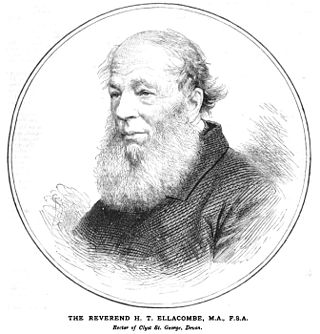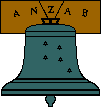Related Research Articles

A carillon ( KERR-ə-lon, kə-RIL-yən) is a pitched percussion instrument that is played with a keyboard and consists of at least 23 bells. The bells are cast in bronze, hung in fixed suspension, and tuned in chromatic order so that they can be sounded harmoniously together. They are struck with clappers connected to a keyboard of wooden batons played with the hands and pedals played with the feet. Often housed in bell towers, carillons are usually owned by churches, universities, or municipalities. They can include an automatic system through which the time is announced and simple tunes are played throughout the day.

Change ringing is the art of ringing a set of tuned bells in a tightly controlled manner to produce precise variations in their successive striking sequences, known as "changes". This can be by method ringing in which the ringers commit to memory the rules for generating each change, or by call changes, where the ringers are instructed how to generate each change by instructions from a conductor. This creates a form of bell music which cannot be discerned as a conventional melody, but is a series of mathematical sequences.
Campanology is the scientific and musical study of bells. It encompasses the technology of bells – how they are founded, tuned and rung – as well as the history, methods, and traditions of bellringing as an art.

The Yale Memorial Carillon is a carillon of 54 bells in Harkness Tower at Yale University in New Haven, Connecticut.

A bell is a directly struck idiophone percussion instrument. Most bells have the shape of a hollow cup that when struck vibrates in a single strong strike tone, with its sides forming an efficient resonator. The strike may be made by an internal "clapper" or "uvula", an external hammer, or—in small bells—by a small loose sphere enclosed within the body of the bell.

John Taylor Bell Foundry (Loughborough) Limited, trading as John Taylor & Co and commonly known as Taylor's Bell Foundry, Taylor's of Loughborough, or simply Taylor's, is the world's largest working bell foundry. It is located in Loughborough, in the Charnwood borough of Leicestershire, England. The business originated in the 14th century, and the Taylor family took over in 1784.

Steeple Aston is a village and civil parish on the edge of the Cherwell Valley, in the Cherwell District of Oxfordshire, England, about 12 miles (19 km) north of Oxford, 7 miles (11 km) west of Bicester, and 10 miles (16 km) south of Banbury. The 2011 Census recorded the parish population as 947. The village is 108 metres (354 ft) above sea level. The River Cherwell and Oxford Canal pass 1 mile (2 km) east of the village. The river forms part of the eastern boundary of the parish. The parish's southern boundary, 1⁄2 mile (800 m) south of the village, also forms part of Cherwell District's boundary with West Oxfordshire.
The Oxford University Society of Change Ringers, founded in 1872, is the official society dedicated to change ringing in Oxford University. Its objects are to promote the art of change ringing in the university and to ring for Sunday services in Oxford during full term.

The Nottingham University Society of Change Ringers (NUSCR) is one of the oldest societies affiliated to the University of Nottingham Students' Union, being founded in 1958. Its principal aim is to allow students from both the University of Nottingham and Nottingham Trent University to practise English Change Ringing. It also represents the University at the annual Northern Universities Association (NUA) Striking Competition each November.
The North American Guild of Change Ringers (NAGCR) was founded in 1972 after the hanging of a ring of bells in the Washington National Cathedral in Washington, D.C., United States, in 1964. The NAGCR has now grown and expanded to 52 bell towers across the United States and Canada as well as one mini-ring and 9 hand-bell groups with more than 500 members residing in North America. This organization performs the art of change ringing or method ringing, a form of campanology, in the towers and on hand-bells. This art uses mathematical sequences and patterns to change bell orders to carry out these sequences. Change ringing began in England in the 17th century.
The Company of Ringers of the Blessed Virgin Mary of Lincoln ring the bells of Lincoln Cathedral. It practises the English style of change ringing.

A bell-ringer is a person who rings a bell, usually a church bell, by means of a rope or other mechanism.
Fabian Stedman (1640–1713) was an English author and a leading figure in the early history of campanology, particularly in the field of method ringing. He had a key role in publishing two books Tintinnalogia and Campanalogia which are the first two publications on the subject. He is also regarded as being a pioneer in the branch of mathematics known as Group theory.

Vivienne Frances Faull is a British Anglican bishop and Lord Spiritual. Since 2018, she has served as the Bishop of Bristol. In 1985, she was the first woman to be appointed chaplain to an Oxbridge college. She was later a cathedral dean, and the only female cathedral provost in Church of England history, having served as Provost of Leicester from 2000 to 2002.

Henry Thomas Ellacombe or Ellicombe (1790-1885), was an English divine and antiquary. He was the inventor of an apparatus to allow a single ringer to ring multiple bells.
The Central Council of Church Bell Ringers (CCCBR) is an organisation founded in 1891 which represents ringers of church bells in the English style.

The Australian and New Zealand Association of Bellringers, known as ANZAB, is the organisation responsible for the promotion of English-style "full circle ringing" – namely change ringing and method ringing in bell towers with a peal of bells – across Australia and New Zealand.

The Suffolk Guild of Ringers for the Diocese of St Edmundsbury and Ipswich is a society and charity supporting the bell ringers and rings of bells in the Diocese of St Edmundsbury and Ipswich who practice the art of change ringing. The Guild was established on 2 April 1923 at Ipswich and covers over 200 rings of bells in the county of Suffolk in the area that falls within the diocese boundary.
Campanology is the scientific and musical study of bells. It encompasses the technology of bells – how they are cast, tuned, and rung – as well as the history, methods, and traditions of bellringing as an art. Articles related to campanology include:
References
- ↑ Central Council of Church Bell Ringers Retrieved April 2017